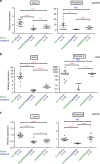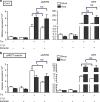Systemic signaling contributes to the unfolded protein response of the plant endoplasmic reticulum
- PMID: 30254194
- PMCID: PMC6156401
- DOI: 10.1038/s41467-018-06289-9
Systemic signaling contributes to the unfolded protein response of the plant endoplasmic reticulum
Abstract
The unfolded protein response (UPR) of the endoplasmic reticulum constitutes a conserved and essential cytoprotective pathway designed to survive biotic and abiotic stresses that alter the proteostasis of the endoplasmic reticulum. The UPR is typically considered cell-autonomous and it is yet unclear whether it can also act systemically through non-cell autonomous signaling. We have addressed this question using a genetic approach coupled with micro-grafting and a suite of molecular reporters in the model plant species Arabidopsis thaliana. We show that the UPR has a non-cell autonomous component, and we demonstrate that this is partially mediated by the intercellular movement of the UPR transcription factor bZIP60 facilitating systemic UPR signaling. Therefore, in multicellular eukaryotes such as plants, non-cell autonomous UPR signaling relies on the systemic movement of at least a UPR transcriptional modulator.
Conflict of interest statement
The authors declare no competing interests.
Figures





Similar articles
-
Recovery from temporary endoplasmic reticulum stress in plants relies on the tissue-specific and largely independent roles of bZIP28 and bZIP60, as well as an antagonizing function of BAX-Inhibitor 1 upon the pro-adaptive signaling mediated by bZIP28.Plant J. 2018 Jan;93(1):155-165. doi: 10.1111/tpj.13768. Epub 2017 Dec 2. Plant J. 2018. PMID: 29124827 Free PMC article.
-
Salicylic acid-independent role of NPR1 is required for protection from proteotoxic stress in the plant endoplasmic reticulum.Proc Natl Acad Sci U S A. 2018 May 29;115(22):E5203-E5212. doi: 10.1073/pnas.1802254115. Epub 2018 May 14. Proc Natl Acad Sci U S A. 2018. PMID: 29760094 Free PMC article.
-
Endoplasmic reticulum proteins quality control and the unfolded protein response: the regulative mechanism of organisms against stress injuries.Biofactors. 2014 Nov-Dec;40(6):569-85. doi: 10.1002/biof.1194. Epub 2014 Dec 20. Biofactors. 2014. PMID: 25530003 Review.
-
Susceptibility factor RTP1 negatively regulates Phytophthora parasitica resistance via modulating UPR regulators bZIP60 and bZIP28.Plant Physiol. 2021 Jun 11;186(2):1269-1287. doi: 10.1093/plphys/kiab126. Plant Physiol. 2021. PMID: 33720348 Free PMC article.
-
Evolution of the unfolded protein response in plants.Plant Cell Environ. 2021 Aug;44(8):2625-2635. doi: 10.1111/pce.14063. Epub 2021 May 2. Plant Cell Environ. 2021. PMID: 33840122 Review.
Cited by
-
The Arabidopsis Protein Disulfide Isomerase Subfamily M Isoform, PDI9, Localizes to the Endoplasmic Reticulum and Influences Pollen Viability and Proper Formation of the Pollen Exine During Heat Stress.Front Plant Sci. 2020 Dec 29;11:610052. doi: 10.3389/fpls.2020.610052. eCollection 2020. Front Plant Sci. 2020. PMID: 33447253 Free PMC article.
-
Endoplasmic reticulum-targeting activatable nanophotosensitizers for hypoxia relief and enhanced photodynamic therapy.Chem Sci. 2025 May 6;16(24):10909-10917. doi: 10.1039/d5sc00534e. eCollection 2025 Jun 18. Chem Sci. 2025. PMID: 40395379 Free PMC article.
-
Development of a GFP biosensor reporter for the unfolded protein response-signaling pathway in plants: incorporation of the bZIP60 intron into the GFP gene.Plant Signal Behav. 2022 Dec 31;17(1):2098645. doi: 10.1080/15592324.2022.2098645. Plant Signal Behav. 2022. PMID: 35856340 Free PMC article.
-
Maintaining the structural and functional homeostasis of the plant endoplasmic reticulum.Dev Cell. 2021 Apr 5;56(7):919-932. doi: 10.1016/j.devcel.2021.02.008. Epub 2021 Mar 3. Dev Cell. 2021. PMID: 33662257 Free PMC article. Review.
-
Coping with Abiotic Stress in Plants-An Endomembrane Trafficking Perspective.Plants (Basel). 2022 Jan 27;11(3):338. doi: 10.3390/plants11030338. Plants (Basel). 2022. PMID: 35161321 Free PMC article. Review.
References
Publication types
MeSH terms
Substances
Grants and funding
- R01 GM101038/GM/NIGMS NIH HHS/United States
- GM101038/U.S. Department of Health & Human Services | National Institutes of Health (NIH)/International
- DE-FG02-91ER20021/U.S. Department of Energy (DOE)/International
- DE-FC02-07ER64494/U.S. Department of Energy (DOE)/International
- MCB1714561/National Science Foundation (NSF)/International
LinkOut - more resources
Full Text Sources
Other Literature Sources
Molecular Biology Databases

